
Muzzle brake
Encyclopedia
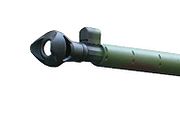
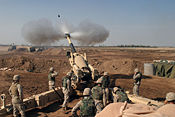
Firearm
A firearm is a weapon that launches one, or many, projectile at high velocity through confined burning of a propellant. This subsonic burning process is technically known as deflagration, as opposed to supersonic combustion known as a detonation. In older firearms, the propellant was typically...
or cannon
Cannon
A cannon is any piece of artillery that uses gunpowder or other usually explosive-based propellents to launch a projectile. Cannon vary in caliber, range, mobility, rate of fire, angle of fire, and firepower; different forms of cannon combine and balance these attributes in varying degrees,...
to redirect propellant gases with the effect of countering both recoil
Recoil
Recoil is the backward momentum of a gun when it is discharged. In technical terms, the recoil caused by the gun exactly balances the forward momentum of the projectile and exhaust gasses, according to Newton's third law...
of the gun
Gun
A gun is a muzzle or breech-loaded projectile-firing weapon. There are various definitions depending on the nation and branch of service. A "gun" may be distinguished from other firearms in being a crew-served weapon such as a howitzer or mortar, as opposed to a small arm like a rifle or pistol,...
and unwanted rising of the barrel during rapid fire. Muzzle brakes are very useful for combat and timed competition shooting, and are commonly found on rifles firing very large cartridges (often big-game rifles), as well as some artillery
Artillery
Originally applied to any group of infantry primarily armed with projectile weapons, artillery has over time become limited in meaning to refer only to those engines of war that operate by projection of munitions far beyond the range of effect of personal weapons...
and tank
Tank
A tank is a tracked, armoured fighting vehicle designed for front-line combat which combines operational mobility, tactical offensive, and defensive capabilities...
guns. They are also commonly used on pistols for practical pistol
Practical shooting
Practical shooting is a sport which challenges an individual's ability to shoot rapidly and accurately with a full-power handgun, rifle, or shotgun. To do this, shooters take on obstacle-laden shooting courses called stages, some requiring many shots to complete, and others just a few...
competitions, and are usually called compensators in this context.
Terminology
The term muzzle brake was introduced in the context of artillery, but it is also used for rifles and pistols. It defines a device that reduces the recoil of the weapon by directing the propellant gases backwards. The force generated at the muzzle brake baffles or ejector ports acts in the opposite direction to the force of recoil, thus reducing wear on the recoil-damping mechanism and allowing a lighter design. In the case of smaller caliber firearms such as rifles it reduces the effects of kickback on the shooter.The terms recoil brake and recoil check are seldom used and never in artillery parlance. The terms recoil compensator, compensator, Mag-na-port and others belong to shooters' lingo and refer to devices that serve to direct propellant gases upwards to reduce muzzle climb and to some extent also the recoil in hand firearms like pistols and revolvers, and also in small-calibre automatic weapons like assault rifles, PDW
Personal defense weapon
A personal defense weapon is a compact semi-automatic or fully automatic firearm similar in most respects to a submachine gun, but firing an armor-piercing rifle round, giving a PDW better range, accuracy and armor-penetrating capability than submachine guns, which fire pistol-caliber cartridges...
s etc. With the exception of names for proprietary systems, such as Mag-na-porting and hybrid compensators, and brand names such as Muzzle Tamer, the various terms in the hand firearm parlance are used interchangeably.
Muzzle rise or climb
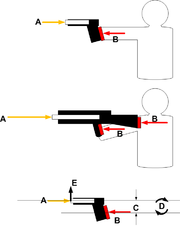
Muzzle rise
The interchangeable terms muzzle rise, muzzle flip and muzzle climb refer to the tendency of firearms or pneumatic arms front end to rise up after firing....
, muzzle flip, or muzzle climb
Muzzle climb
Muzzle climb refers to the elevation of muzzle of automatic and rapid-fire semi-automatic firearms caused by combined recoil from multiple shots being fired in quick succession....
refer to the tendency of a firearm's front end (the muzzle end of the barrel) to rise up after firing.
The primary reason for muzzle rise is that for nearly all firearms, the centerline of the barrel is above the center of contact between the shooter and the firearms' grips and stock. The forces from the bullet being fired and the propellant gases exiting the muzzle act directly down the centerline of the barrel. If that line of force is above the center of the contact points, this creates a moment
Torque
Torque, moment or moment of force , is the tendency of a force to rotate an object about an axis, fulcrum, or pivot. Just as a force is a push or a pull, a torque can be thought of as a twist....
or torque
Torque
Torque, moment or moment of force , is the tendency of a force to rotate an object about an axis, fulcrum, or pivot. Just as a force is a push or a pull, a torque can be thought of as a twist....
rotational force. That torque causes the firearm to rotate, and the muzzle end to rise upwards. The M1946 Sieg automatic rifle
M1946 Sieg automatic rifle
The M1946 Sieg automatic rifle was a bullpup battle rifle / light machine gun designed by James E. Sieg of the US Coast Guard. The weapon, introduced to the public in 1946, was chambered in the .30-06 round, fed from 20 round magazines and is capable of firing around 650-700RPM in full automatic...
had an unusual Muzzle brake that made the rifle climb downwards, but enabled the user to fire it with one hand in full automatic.
Firearms with less height from the grip line to the barrel centerline will tend to experience less muzzle rise.
Concept
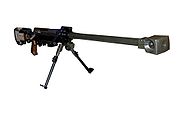
M47 Patton
The M47 Patton is an American medium tank, the second tank to be named after General George S. Patton, commander of the U.S. Third Army during World War II and one of the earliest American advocates of tanks in battle. It was a further development of the M46 Patton tank.-History:The M47 was the U.S...
. This consists of a small length of tubing mounted at right angles to the end of the barrel. Brakes most often utilize slots, vents, holes, baffles, and similar devices. The strategy of a muzzle brake is to redirect and control the burst of combustion gases that follows the departure of a projectile.
In conventional muzzle brake designs, combustion gases depart the muzzle brake at an angle (or direction) to the muzzle. This creates a force which helps to counteract the rearward movement of the barrel (due to recoil) as well as the upward rise of the muzzle. The effect can be compared to reverse thrust systems on aircraft jet engines. The mass and velocity of the gases is significant enough to move the firearm in the opposite direction of recoil. On the AKM
AKM
The AKM is a 7.62mm assault rifle designed by Mikhail Kalashnikov. It is an upgraded version of the AK-47 rifle and was developed in the 1950s....
assault rifle, the brake is angled slightly to the right to counteract the sideways movement of the gun under recoil.
Another method of redirecting gases is called porting. Porting involves creating ports or holes that are precision-drilled into the forward part of the barrel
Gun barrel
A gun barrel is the tube, usually metal, through which a controlled explosion or rapid expansion of gases are released in order to propel a projectile out of the end at a high velocity....
(and slide
Pistol slide
The slide is the part of the weapon on a majority of semi-automatic pistols that moves during the operating cycle and generally houses the firing pin or striker and the extractor, and serves as the bolt...
on pistol
Pistol
When distinguished as a subset of handguns, a pistol is a handgun with a chamber that is integral with the barrel, as opposed to a revolver, wherein the chamber is separate from the barrel as a revolving cylinder. Typically, pistols have an effective range of about 100 feet.-History:The pistol...
s). These holes are designed to divert a portion of the gases expelled prior to the departure of the bullet in the direction that reduces the tendency of the firearm to flip upwards. The concept applies Newton's third law
Newton's laws of motion
Newton's laws of motion are three physical laws that form the basis for classical mechanics. They describe the relationship between the forces acting on a body and its motion due to those forces...
: the exhaust directed upward causes a reciprocal force downward. Porting is most commonly used on shotgun
Shotgun
A shotgun is a firearm that is usually designed to be fired from the shoulder, which uses the energy of a fixed shell to fire a number of small spherical pellets called shot, or a solid projectile called a slug...
s, where recoil is most significant and makes rapid firing difficult. Even single shots of magnum-strength loads are uncomfortable for all but the most seasoned shooters. Porting has obvious advantages for faster follow-up shots, especially for 3-round burst
Burst mode (firearm)
In automatic firearms, burst mode or burst fire is a firing mode enabling the shooter to fire a predetermined number of rounds, usually 2 or 3 rounds and 100+ on anti-aircraft weapons, with a single pull of the trigger. This firing mode is commonly used in submachine guns, assault rifles and carbines...
operation.
Another strategy (besides redirecting gases) for counteracting muzzle rise involves slowing the departure of combustion gases. Slowing of the gases is the method used on suppressor
Suppressor
A suppressor, sound suppressor, sound moderator, or silencer, is a device attached to or part of the barrel of a firearm which reduces the amount of noise and flash generated by firing the weapon....
s and linear compensators.
Construction
Construction of a brake or compensator can be very simple; for example, some models of the AK-47AK-47
The AK-47 is a selective-fire, gas-operated 7.62×39mm assault rifle, first developed in the Soviet Union by Mikhail Kalashnikov. It is officially known as Avtomat Kalashnikova . It is also known as a Kalashnikov, an "AK", or in Russian slang, Kalash.Design work on the AK-47 began in the last year...
used a diagonal cut at the muzzle end of the barrel to direct some of the escaping gases upwards. Another simple method is porting, where holes or slots are machined in the barrel near the muzzle to allow the gas to escape.
More advanced designs use baffles and expansion chambers to slow down the escaping gases; this is the basic principle behind a linear compensator. Ports are often added to the expansion chambers, producing the long, multi-chambered recoil compensators often seen on IPSC
International Practical Shooting Confederation
The International Practical Shooting Confederation is a shooting sport based on the concept of practical shooting. Accuracy, power and speed are all required to achieve a maximum score.-Founding and organization:...
raceguns.
Utility

Advantages of muzzle brakes
Though there are numerous ways of measuring the energy of a recoil impulse, it's generally true that between a 10% and 50% reduction can be measured. There are, however, muzzle brake manufacturers that claim greater recoil reduction percentages. Muzzle brakes need sufficient propellant gas volume and high gas pressure at the muzzle of the gun to achieve good measured recoil reduction percentages. This means cartridges with a large bore area to case volume ratio combined with a high operating pressure benefit more from recoil reduction with muzzle brakes than smaller standard cartridges.Besides reducing felt recoil, one of the primary advantages of a muzzle brake is the reduction of muzzle rise. This allows a weapon's sights to be realigned more quickly. This is relevant particularly for fully automatic weapons. Muzzle rise is often entirely eliminated by an efficient design. Because the rifle moves rearward less, the shooter has little to compensate for. This is particularly true of rapid-fire, fully automatic fire, and large-bore hunting rifles. They are also common on small-bore vermin
Vermin
Vermin is a term applied to various animal species regarded by some as pests or nuisances and especially to those associated with the carrying of disease. Since the term is defined in relation to human activities, which species are included will vary from area to area and even person to person...
rifles, where reducing the muzzle rise allows the shooter to see the bullet impact through a telescopic sight
Telescopic sight
A telescopic sight, commonly called a scope, is a sighting device that is based on an optical refracting telescope. They are equipped with some form of graphic image pattern mounted in an optically appropriate position in their optical system to give an accurate aiming point...
. A reduction in recoil also reduces the chance of undesired (painful) contacts between the shooter's head and the ocular of a telescopic sight or other aiming components that have to be positioned near the shooter's eye (often referred to as "scope eye"). Another advantage of a muzzle brake is a reduction of recoil fatigue during extended practice sessions, enabling the shooter to consecutively fire more rounds accurately. Further, flinch (involuntary pre trigger release anxiety behaviour resulting in inaccurate aiming and shooting) caused by excessive recoil may be significantly reduced or eliminated with certain shooters.
Disadvantages of muzzle brakes

Noise
Measurements indicate that on a rifle a muzzle brake adds 5 to 10 dB to the normal noise level perceived by the shooter, increasing total noise levels up to 160 dB(A) +/- 3 dB. Painful discomfort occurs at approximately 120 to 125 dB(A), with some references claiming 133 dB(A) for the threshold of pain. Active ear muffs are available with electronic noise cancellation that can reduce direct path ear canal noise by approximately 17-33 dB, depending on the low, medium, or high frequency at which attenuation is measured. Passive ear plugs vary greatly in their measured attenuation, ranging from approximately 20 dB to 30 dB, depending on whether or not they are properly used. Using both ear muffs (whether passive or active) and ear plugs simultaneously is a practice that is often used for obtaining the maximum protection, but the efficacy of such combined protection relative to preventing permanent ear damage is not conclusive, with evidence indicating that a combined noise reduction ratio (NRR) of only 36 dB (C-weighted) is the maximum possible using ear muffs and ear plugs simultaneously, equating to only a 36 - 7 = 29 dB protection against a 160 dB(A) noise level. Relative to a noise level of 160 dB(A), this means that even using ear muffs and ear plugs simultaneously cannot protect a shooter against permanent ear damage when using a muzzle brake, through leaving a shooter exposed to noise levels of approximately 131 dB(A) that is 11 dB above the point where permanent ear damage occurs.In the European Union
European Union
The European Union is an economic and political union of 27 independent member states which are located primarily in Europe. The EU traces its origins from the European Coal and Steel Community and the European Economic Community , formed by six countries in 1958...
(EU), employees are protected by law against impulsive or impact noise exposure over 137 dB(A), with an absolute limit of 140 dB(A). Individual member states often define even lower levels by national law; the United Kingdom, for instance, opted for 120 dB(A), which is where many references indicate that permanent ear damage occurs. The duration of exposure is likewise limited, for environmental noise above 90 dB(A) in the United States by OSHA rules, and for environmental noise above 80 dB(A) in the European Union, for exposure over an entire work day. The EU legislation demands the noise has to be reduced at the origin in the technically best possible way. Professional small arms and artillery users such as military and police personnel, etc., have to be issued with adequately working suppressors or hearing protection to reduce noise to levels as defined by law, since an employer has to anticipate legal action and compensations in cases where an employee that used the provided protective gear suffers work-induced health damage.
Bulk
Brakes and compensators are additionally often quite bulky, adding length, diameter, and mass to the muzzle end of the firearm, where it will most influence its handling. Further, flinch caused by blast induced sinus cavity concussion discomfort experienced by the shooter can become a problem for anti-materiel rifleAnti-materiel rifle
An anti-materiel rifle is a rifle that is designed for use against military equipment rather than against other combatants ....
shooters due to the big cartridges these rifles fire.
Visibility
A serious tactical disadvantage of muzzle brakes on both small arms and artillery is that, depending on their designs, they may cause escaping gases to throw up dust and debris clouds that impair visibility and reveal one's position, not to mention posing a hazard to individuals without eye protection. Troops often wet the ground in front of antitank guns in defensive emplacements to prevent this, and snipers are specially trained in techniques for suppressing or concealing the magnified effects of lateral muzzle blast when firing rifles with such brakes. Linear compensators and suppressorSuppressor
A suppressor, sound suppressor, sound moderator, or silencer, is a device attached to or part of the barrel of a firearm which reduces the amount of noise and flash generated by firing the weapon....
s do not have the disadvantages of a redirected muzzle blast; they actually reduce the blast by venting high pressure gas forward at reduced velocity.
Legality
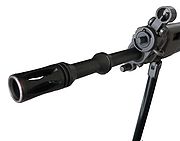
Bureau of Alcohol, Tobacco, Firearms and Explosives
The Bureau of Alcohol, Tobacco, Firearms and Explosives is a federal law enforcement organization within the United States Department of Justice...
in the United States a short time after the now defunct Federal assault weapons ban
Federal assault weapons ban
The Federal Assault Weapons Ban was a subtitle of the Violent Crime Control and Law Enforcement Act of 1994, a federal law in the United States that included a prohibition on the manufacture for civilian use of certain semi-automatic firearms, so called "assault weapons"...
went into effect in 1994. These muzzle attachments were legal to attach to a threaded barrel, so long as they were welded in place on certain firearms (high temperature silver solder also sufficed). On the other hand, flash suppressor
Flash suppressor
A flash suppressor, also known as a flash guard, flash eliminator, flash hider, or flash cone, is a device attached to the muzzle of a rifle or other gun that reduces the visible signature of the burning gases that exit the muzzle. This reduces the chances that the shooter will be blinded in dark...
s and barrel shrouds were seen as 'military' features, and were on the list of features that, provided enough features were present, defined the rifle as illegal, if manufactured after the effective date of the ban. This meant, in practice, muzzle brakes had to be certified by the ATF to prevent end-users from accidentally violating the law and installing a device that could later be found to be defined legally as being more of a flash suppressor than a muzzle brake, even if marketed and sold as a muzzle brake, if incidental flash suppression was deemed to be 'significant' by the ATF. The Federal laws governing this expired in 2004, and are no longer of active concern, except in those few jurisdictions in which certain provisions are still retained in specific state laws.
In some African jurisdictions where big game hunting
Big game hunting
Big game hunting is the hunting of large game. The term is historically associated with the hunting of Africa's Big Five game , and with tigers and rhinos on the Indian subcontinent. In North America, animals such as bears and bison were hunted...
is commonplace, rifles (typically firing extremely powerful loads) equipped with muzzle brakes are banned due to hearing damage hazard to scouts and guides without hearing protection.

